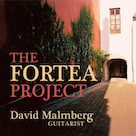

David Malmberg: The Fortea Project
Op Cit Id Records
American finger-style guitarist David Malmberg is anything if not versatile. While his site's home page includes a sample playlist featuring popular songs by The Beatles, James Taylor, Duke Ellington, Dave Brubeck, Steely Dan, and others, the Saint Paul, Minnesota-based guitarist is as comfortable tackling material by classical composers. In addition to holding a Master's degree in music, Malmberg studied with America Martinez Serrano at the Conservatorio De Musica in Sevilla and flamenco guitarist Oscar Herrero from Madrid, exposure that primed him well for this recent release featuring solo guitar works by Spanish guitarist, composer, and music educator Daniel Fortea (1878-1953). It's worth noting that Martinez was a pupil of Fortea's and served as his guitar assistant in Madrid in the mid-‘30s.
Fortea was, like Malmberg, versatile and gifted. In his childhood, he learned clarinet, bandurria, and guitar and later learned piano and the fundamentals of the violin. Early in his career he studied with the great guitarist Francisco Tarrega and in 1909 founded his own music school in Madrid and established the Biblioteca Fortea (aka the Fortea Library), which contains the music he wrote for guitar and obviously serves as an invaluable resource for contemporary guitarists.
Two settings from Estudios poéticos (1929) initiate the release, which presents a generous nineteen tracks. Clarity of articulation and well-considered tempo choices distinguish Malmberg's playing in “Dialagando” and “Serenata,” both settings endearing for their melodicism, stateliness, and directness of expression. In their song-like construction, Fortea's pieces are accessible and relatable, and the absence of clutter in the arrangements is welcome too. Representative of the music on offer, “Toledo,” “Cuento Infantil,” and “Preludio en Re” beguile for the charm of their folk-like expressions; Malmberg's precise picking in “Mi Favorita,” on the other hand, amplifies the Spanish character of the writing. The material ranges from joyful to tender, with some pieces celebratory and others, such as “Estoy Solo” and “Balada,” marked by gentleness and melancholy. With its lilting flow, the poetic reverie “Caprichio” induces swoon; the pretty “Gavotte #2” does the same when it exudes a faint hint of Baroque flavour. While many a setting is delivered at a slow to middle tempo, “Preludio En La” barrels forth energetically, its flowing patterns rarely stopping to catch their breath. A wide array of guitar techniques—expertly executed chords, arpeggios, strums, and single-picked lines—is drawn upon for these performances, which hew faithfully to the scores as written. All but one of the pieces last no more than one to three minutes at a time, which makes the five-minute “Mi Refugio” stand out on duration grounds alone.
While the packaging for the release gives The Fortea Project as the title, the release is, in fact, the first volume of two recorded by Malmberg. Listeners captivated by this initial set will likely want to acquire the second one too, which released in April 2025, is ready and waiting. Are Malmberg's definitive renditions of Fortea's material? No, but no interpreter's versions are ever the final word, and it's possible better treatments by other guitarists exist and will appear in the future. That said, Malmberg's performances are credible and commendably faithful to the spirit of the originals. At the very least, he deserves credit for bringing attention to Fortea, both as an essential figure in the history of classical guitar and for his music. Young and aspiring classical guitarists owe Malmberg a debt of gratitude for the public service he's performed with the project.June 2025